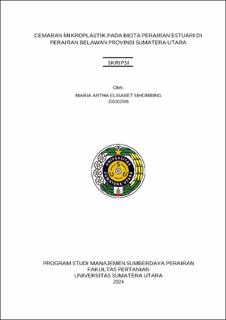Cemaran Mikroplastik pada Biota Perairan Estuari di Perairan Belawan Provinsi Sumatera Utara
Microplastic Contamination of Aquatic Biota in The Belawan Water Estuary, North Sumatra

Date
2024Author
Sihombing, Maria Artha Elisabet
Advisor(s)
Muhtadi, Ahmad
Fadhilah, Amanatul
Metadata
Show full item recordAbstract
Belawan Waters is an estuary that receives water from the Deli River and several other rivers around Medan. Currently, Belawan waters are highly polluted by waste originating from various human sources, including household and industrial waste. The shape of microplastics is often used to determine the category of microplastics and find out the source of the microplastics. Fiber-type microplastics come from residential areas in coastal areas with the majority of people working as fishermen. This research aims to determine the form and amount of microplastics in estuarine biota in Belawan Waters and to determine the comparison of the abundance of microplastics in estuarine water biota in Belawan Waters. This research will be carried out from October to November 2023 and includes sampling, measuring physico-chemical parameters of waters, testing and analyzing samples in the laboratory, and data analysis. The location for sampling and measuring environmental parameters was carried out in the Belawan Estuary Waters, North Sumatra Province with sunny and cloudy weather conditions. Analysis of samples of aquatic biota such as fish and crustaceans was carried out at the Biology and Aquaculture Laboratory and Plant Disease Laboratory, Faculty of Agriculture, University of North Sumatra. The research results showed that the greatest abundance of microplastics was in carnivorous fish species, namely 69.57 particles/g. The most microplastics were in the living habitat of demersal fish, namely 64.025 particles/g. The fish group was 63.649 particles/g, while in the crustacean group, it was 63,899 particles/g. 30,965 particles/gr. Polyethylene, polypropylene, Polyvinyl chloride, and polystyrene are the types of polymers determined by the FT-IR test.
Collections
- Undergraduate Theses [792]
